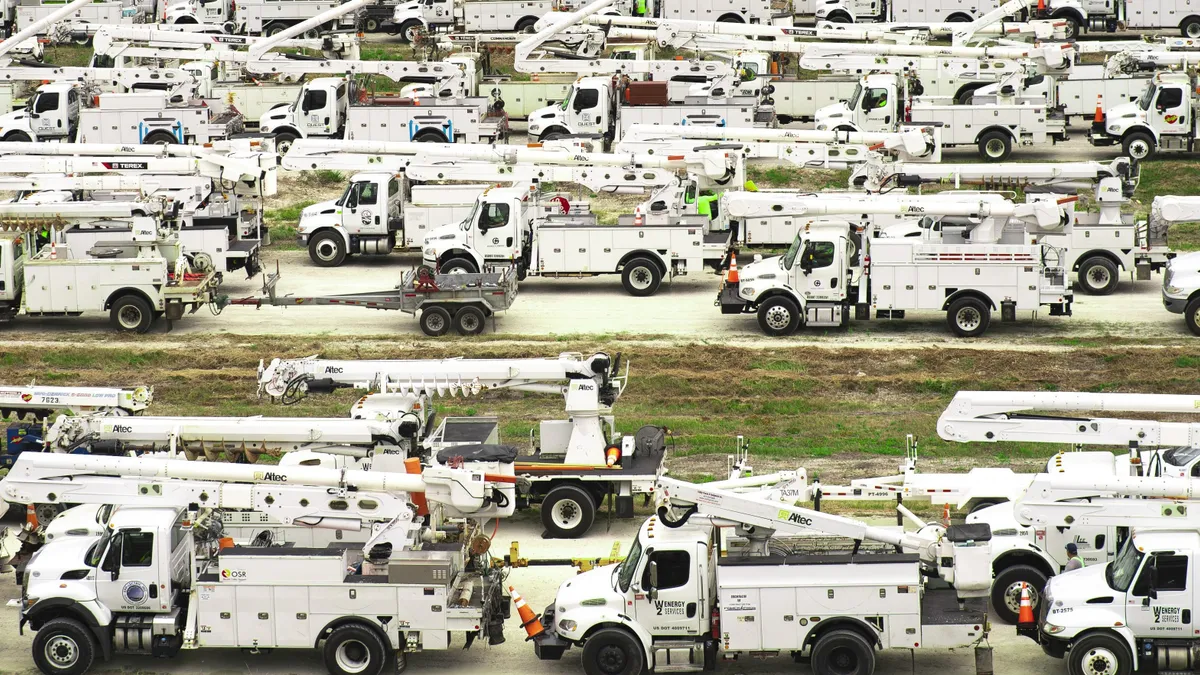About 3.4 million electric customers were without power in Florida on Thursday morning after Hurricane Milton hit the state’s western shore on its way toward the Atlantic Ocean, according to PowerOutage.us.
Milton, a Category 5 hurricane that slowed to a Category 3 by the time it made landfall, comes about two weeks after Hurricane Helene caused nearly 6 million power outages across the Southeast. About 63,000 customers still remain without power in North Carolina and about 35,000 customers lack electricity in Georgia in the wake of that storm, according to PowerOutage.us.
Florida Power & Light, a NextEra Energy subsidiary, reported that about 1.2 million of its 5.4 million customers were without power Thursday morning after Hurricane Milton crossed the state.
Tampa Electric, an Emera subsidiary that serves the area where Milton hit Florida’s west coast, reported it had about 594,000 power outages, affecting about 71% of its roughly 840,000 customers, on Thursday morning.
About 923,000 of Duke Energy Florida’s 2 million customers lacked power Thursday morning, according to the utility.
On Wednesday, the U.S. Department of Energy issued an emergency order giving Duke permission to run its 1,640-MW Citrus combined cycle plant in Crystal River, Florida, as needed to meet electricity demand and protect the reliability of the electric system due to Hurricane Milton, according to the utility.
Withlacoochee River Electric Cooperative, which serves an area north of Tampa, reported it had about 124,000 customers experiencing outages, and Peace River Electric Cooperative said it had about 54,000 customers dealing with outages.
More than 50,000 utility workers from at least 42 states, the District of Columbia and Canada are dedicated to the Milton response, according to the Edison Electric Institute, a trade group for investor-owned utilities. Workers and equipment were pre-positioned in and near Florida, EEI said.
Milton could cause widespread damage to electric distribution across Florida, according to David Kamran, assistant vice president for Moody’s Ratings.
“However, municipal electric and gas utilities are largely expected to be financially insulated given measures to counteract any losses of revenue and support for the restoration of electric distribution,” Kamran said in a statement on Wednesday. “Besides generally healthy financial positions, these entities also benefit from FEMA support which usually covers 75% of recovery costs, as well as mutual aid agreements coordinated by the Florida Municipal Electric Association.”
Milton was the most rapidly intensifying hurricane since Wilma in 2005, partly driven by warming water in the Gulf of Mexico, an effect of climate change, according to Helen Hooker, a flooding, climate change and tropical cyclones research scientist at the University of Reading in England.
Climate change has also led to rising sea levels, making storm surges worse, according to Hooker. “Our warmer atmosphere holds more water, meaning heavier rainfall,” Hooker said in a statement. “More intense rainfall on top of a higher storm surge combines to worsen impacts.”
The power sector accounted for 25% of U.S. greenhouse gas emissions in 2022, making it the second-largest carbon emissions source behind the transportation sector, according to the Environmental Protection Agency.
The U.S. power sector produced 4,807 million metric tons of carbon emissions last year, down 7% from 2022 levels, according to the U.S. Energy Information Administration. The reduction in emissions resulted largely from reduced coal-fired electricity generation, the most carbon-intensive fossil fuel, as natural gas and solar power made up a larger portion of the generation mix, the agency said in an April report.















